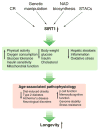The role of mammalian sirtuins in the regulation of metabolism, aging, and longevity
- PMID: 21879449
- PMCID: PMC3745303
- DOI: 10.1007/978-3-642-21631-2_7
The role of mammalian sirtuins in the regulation of metabolism, aging, and longevity
Abstract
Ever since the discovery of sirtuins a decade ago, interest in this family of NAD-dependent deacetylases has exploded, generating multiple lines of evidence implicating sirtuins as evolutionarily conserved regulators of lifespan. In mammals, it has been established that sirtuins regulate physiological responses to metabolism and stress, two key factors that affect the process of aging. Further investigation into the intimate connection among sirtuins, metabolism, and aging has implicated the activation of SIRT1 as both preventative and therapeutic measures against multiple age-associated disorders including type 2 diabetes and Alzheimer's disease. SIRT1 activation has clear potential to not only prevent age-associated diseases but also to extend healthspan and perhaps lifespan. Sirtuin activating compounds and NAD intermediates are two promising ways to achieve these elusive goals.
Figures





References
-
- Ahuja N, Schwer B, Carobbio S, Waltregny D, North BJ, Castronovo V, Maechler P, Verdin E. Regulation of insulin secretion by SIRT4, a mitochondrial ADP-ribosyltransferase. J Biol Chem. 2007;282:33583–33592. - PubMed
-
- Amat R, Planavila A, Chen SL, Iglesias R, Giralt M, Villarroya F. SIRT1 controls the transcription of the peroxisome proliferator-activated receptor-gamma Co-activator-1alpha (PGC-1alpha) gene in skeletal muscle through the PGC-1alpha autoregulatory loop and interaction with MyoD. J Biol Chem. 2009;284:21872–21880. - PMC - PubMed
-
- Araki T, Sasaki Y, Milbrandt J. Increased nuclear NAD biosynthesis and SIRT1 activation prevent axonal degeneration. Science. 2004;305:1010–1013. - PubMed
Publication types
MeSH terms
Substances
Grants and funding
LinkOut - more resources
Full Text Sources
Other Literature Sources
Medical

